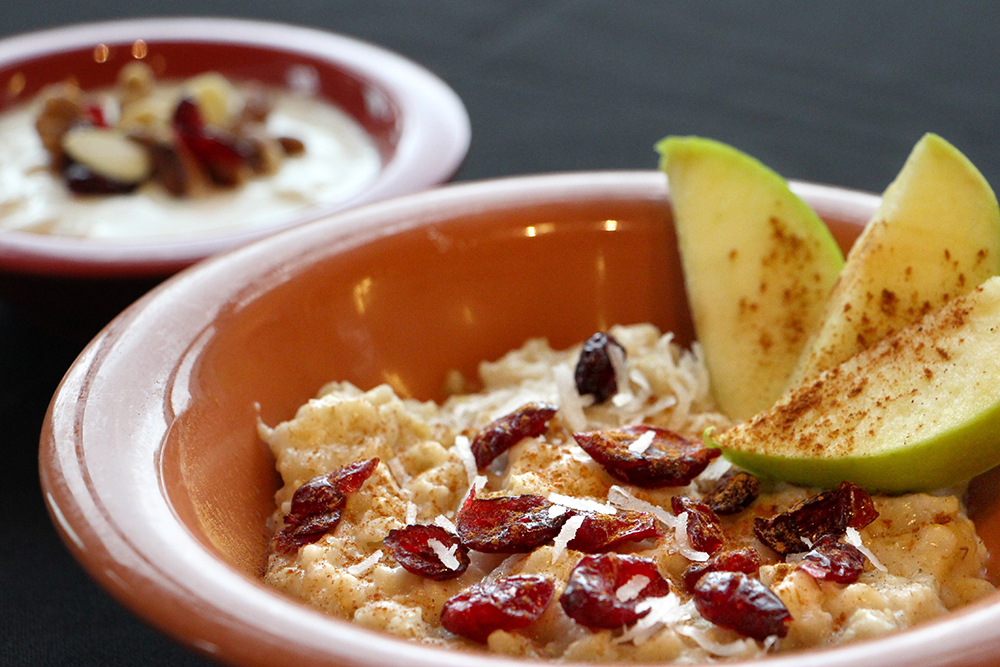Finding Whole Grains
Tuesday, March 30, 2021
By Maggie Green, UGA Dining Nutrition Marketing Intern and 3rd Year Dietetics Major
Did you know on average college students get less than one serving of whole grains
per day? Are college students avoiding whole grains, or do they simply not know what
they are or how to find them. If you feel like you fall into the latter category,
this article will show you how to find whole grain options in both your supermarkets
and dining commons!
First, here is some background on whole grains: Grains are divided into two categories: Whole Grains and Refined
Grains. Whole grains contain the entire grain kernel intact (the bran, germ, and endosperm).
These include whole wheat flour, oatmeal, brown rice, quinoa, and corn. Refined grains
have had the bran and germ of their kernel removed to give a finer texture and increase
shelf life. However, this process depletes the kernel of the beneficial dietary fiber,
iron, and B Vitamins that come from the bran and germ of grains. Refined grains include
white rice, white flour, and white bread.
Now that you know the basis of what a whole grain is, how do you find it in the store? If you are not yet familiar with nutrition labels, they contain information found on the side or back of the product that details the nutrient levels and ingredients. Check the nutrition label for the words “100% whole wheat or grain” in the ingredient list. The words oats, bran, spelt, flax, rye, or barley flour may also be used. Don’t be fooled by the terms “enriched, unbleached, or fortified wheat flour.” These are not whole grains and do not have the same benefits. Often, there is a whole grain sticker that identifies how much whole grain is in a serving of food. These icons make it easy to spot whole grain items while grocery shopping.
How about when you are eating in the dining commons? During Whole Grain Week in National Nutrition Month, whole grains will be labeled with signs saying “I’m a whole grain.” Other weeks, here are some tips you can follow to find whole grains.
- Look for grains that are darker in color. Because whole grains still have the entire kernel intact, they often look brown compared to refined grains. For example, when picking a rice at the Lemon Grass Kitchen, the brown rice is a whole grain while the white rice is not.
- Use UGA’s Build Your Plate website to see the ingredients and nutrient levels of each recipe in the dining commons. Just like the nutrition label on packaged foods, look for the keywords mentioned previously in the ingredient list to determine if the recipe contains whole grains.
Aside from the rotating recipes, here are staple whole grain items that are served daily in the dining commons:
- A quick and easy way to consume more whole grains in the dining commons is to use the permeant cereal bar. This station is constantly putting out whole grains you can eat for breakfast or as a snack. Try the Honey Nut Cheerios, Rice Chex, Frosted Mini-Wheats, Kashi Go Lean, or Raisin Bran for whole grain options. Pair the cereal with milk for protein, and fruit for some added vitamins and fiber to make a complete meal.
- Other places whole grains can be always be found in the dining commons include the whole wheat pasta at the Trattoria Station, the brown rice and ancient grains blend at Lemon Grass Kitchen, oatmeal and whole wheat French toast sticks in the Sunrise Café, and wheat bread at the Deli.
- Some of the Baxter Street Bakery desserts also contain whole grains! Try the Chex Krispy Treats that are served every day.
So now that you know how to identify whole grains and where to find them, how much should you be eating? Experts recommend eating six servings of grain per day, half of which are whole grain. Examples of one serving of whole grains include:
- 1 slice of bread
- ½ cup cooked oatmeal, pasta, or rice
- 1 cup dry cereal
If three servings of whole grains a day is recommended, here are sample meal ideas that you can find at the dining commons to meet your whole grain goals!
- Breakfast: Oatmeal from Sunrise Café with a fruit of choice. Add peanut butter from the bagel station to increase the protein amount!
- Lunch: Brown rice with Thai BBQ chicken or Korean tofu and stir-fried snow peas with shiitake mushrooms.
- Dinner: Mexican Quinoa featured recipe with a side of Italian green beans and a whole grain Chex Krispy Treat for dessert.
Being able to find whole grain options where you eat is important in maintaining a healthy diet. Whole grain consumption has many health benefits, and people who eat whole grains regularly have a reduced risk of many chronic diseases. The high fiber content of whole grains supplies B vitamins, iron, copper, zinc, magnesium, antioxidants, and phytochemicals. These help to lower your cholesterol and maintain steady blood sugar levels. Next time you’re in the dining commons, be sure to find and incorporate whole grains on your plate!
See more blog posts here.